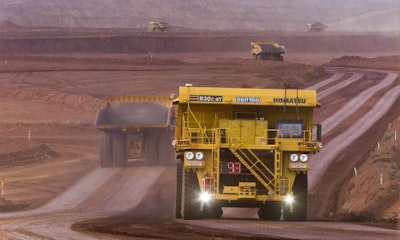
Toronto, Ontario — June 26, 2016 — A wealth of interesting news from the world of autonomous vehicles (AVs) this week, including potential improvements to Tesla’s autopilot feature, driverless mining trucks and China’s deep investment in the Internet of Cars.
– Various new technologies, from 3D printing to automated vehicles, come together in this one self-driving bus. The 3D-printed minibus was unveiled by Arizona-based start-up Local Motors. The bus will be put into service in Washington, D.C. as soon as regulations allow it, according to the CEO of the company, John Rogers. The bus was designed as an “on-demand transportation solution that passengers can summon with a mobile app, like Uber rides.” It can also “be printed to specification in ‘micro factories’ in a matter of hours,” according to a report. Rogers said the bus is ready to go into use and that “Local Motors is about selling (the vehicles) into the markets that are ready now.” Collision Repair magazine has mentioned Local Motors before. The company builds vehicles from the ground up and produces most components with 3D printers. “We hope to be able to print this vehicle in about 10 hours and assemble it in another hour,” said Rogers. The privately held company has 45 investors and can “easily revamp its design based on what a customer wants,” while operating without the large infrastructure costs of traditional automakers.
– The 3D printed bus also features the artifical intelligence program from IBM known as Watson. The program will allow people boarding the bus to say in plain language where it is they want to go. This is the first AV project with which IBM has become involved. The vehicle has more than 30 sensors and streams data from an IBM cloud-based data source. It is even said to be able to discuss why it made specific driving decisions with passengers and can make recommendations for local restaurants.
– Tesla is said to be “willing to improve” its autopilot feature by “sharing data with the government and other companies in order to reach Level 4 autonomy in vehicles,” said Elon Musk recently. The company is offering the US Department of Transportation, “780 million miles of autopilot data, representing 70,000 autopilot-equipped Tesla Model S and Model Xs on the road.” Musk is said to hope this will “speed up regulatory approvals of fully autonomous vehicles.” Level 4 autonomy (as defined by a now famous NHTSA paper that defines Level 1 to 5) means you only have to tell the vehicle where you want to go and the vehicle will take you there. No other input is required. This is a fully-functioning self-driving car. No company “has yet produced a Level 4 autonomy vehicle,” according to a report, “but speculation regarding a supposed ‘big announcement’ by Tesla at the end of 2017 has many wondering whether the automotive technology pioneer has finally achieved this milestone.”
– Another report this week notes that mining giant Rio Tinto now uses 45 240-ton driverless trucks in two of its Australian mines. The report also notes that in San Francisco, “former Googlers have launched a start-up called Otto that promises to retrofit vehicles with driverless capabilities for just $30,000.” Considering the average trucker makes $40,000 a year, a truck company could more than double its investment after just two years if it installs AV tech. Using a computer to calculate the most efficient speed and route will see fuel efficiencies generate savings of $35 billion. The reduction in accidents could save the owners another $36 billion. Expect trucking companies to lobby for the legal reform so they can save on labour, which accounts for 36 percent of the costs per mile.
– The UK’s Guardian newspaper points out there are literally millions of truckers and “millions more whose livelihoods depend on the truckers coming up and down the country, stopping for food, drinks and sleep.” Truck driver is the single largest job in 29 US states. According to the Guardian article, as millions find themselves out of work governments will be forced to undertake “A critical discussion about employment, welfare and universal income.”
– Will China own the Internet of Cars? Apparently. Apple chief Tim Cook invested $1 billion in Chinese company Didi Chuxing in a bid to get in on the rise of the “Internet of Things” as it pertains to Chinese cars. China, of course, is the world’s single biggest auto market now, with 24.6 million cars sold there in 2015. That’s ten million more than the US. According to the report, “…the typical Chinese car buyer is young and permanently connected,” and is deeply interested in car connectivity. According to a 2015 McKinsey survey 60 percent of Chinese new car buyers would switch brands if it meant improved connectivity.” As well, planning documents prepared by the Chinese Communist Goverment demand that “Chinese companies should own 80 percent of the domestic market for vehicle entertainment modules by 2030, and 100 percent of the market for satellite navigation systems.”
– Even Vanity Fair is getting in on the AV trend. A recent issue of the Hollywood celebrity magazine had an interview with the two founders of the ride-sharing company Lyft. The organization recently signed a deal with GM, another automaker that is beginning to refer to itself as a mobility provider. Some of the quotes from the Vanity Fair article clarify what this means: “The experience we’re seeing today is just the tip of the iceberg. And as autonomous vehicles come to market and become more of a mature technology, the majority of the population, we believe, will stop choosing to own a car. When you imagine the experience of being able to open up the app and choosing whatever type of car you want, the car is 30 seconds away, waiting for you, picks you up in an instant—when you’re going to work you can have the cheap commuter car, when you’re going on a family trip you can have a family Lyft, a big SUV, a nice car for date night. You’ll have whatever car you want whenever you want. All the hassles of car ownership go away. You’re never missing a day of work to take your car to the shop. You’re never spending time at a gas station. Parking lots go away. Look at any street and you see cars parked on both sides. That all changes. Ultimately, cities evolve to be built more around people than cars.”
According to the Lyft executive the president of General Motors came to their office toward the end of last year. “They, too, believe that car ownership will change dramatically in the near term, specifically in the urban environment. And they were excited to be part of that….millennials don’t care about cars and don’t want a $9,000 ball and chain.”
Going on to explain how these new devices will be rolled out the Lyft exec explained that, “In the next few years you’re going to start seeing autonomous vehicles on the road, but they’ll have limited capabilities. They won’t be able to drive on every street. They won’t be able to drive above 25 miles an hour. They won’t be able to drive in all-weather conditions. It’ll take those cars a number of years to be able to evolve to handle all conditions. It’ll be a while longer before you’re seeing completely capable autonomous vehicles.”























